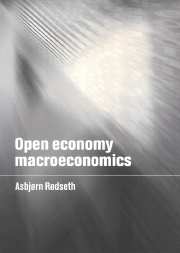Book contents
- Frontmatter
- Contents
- List of figures
- List of tables
- Preface
- List of standard symbols
- Introduction
- Part 1 Financial markets
- Part 2 The open economy
- 5 The extremely open economy
- 6 Home and foreign goods
- 7 Traded and non-traded goods
- 8 Alternative market structures, purchasing power parity and monopolistic competition
- Part 3 Policy issues
- Appendixes
- Notes
- Bibliography
- Index
5 - The extremely open economy
Published online by Cambridge University Press: 06 July 2010
- Frontmatter
- Contents
- List of figures
- List of tables
- Preface
- List of standard symbols
- Introduction
- Part 1 Financial markets
- Part 2 The open economy
- 5 The extremely open economy
- 6 Home and foreign goods
- 7 Traded and non-traded goods
- 8 Alternative market structures, purchasing power parity and monopolistic competition
- Part 3 Policy issues
- Appendixes
- Notes
- Bibliography
- Index
Summary
After four chapters on the financial markets, it is time to shift focus to the markets for goods and for labour. In chapters 5–8 we shall explore the determination of output, employment, the current account, the foreign debt and the rate of inflation. However, the financial markets will not be left out. One main purpose of chapters 5–7 is to describe the links between the foreign exchange market and the goods market. These go both ways. In section 1.6 we saw that a current account deficit may lead to a gradual depreciation of the exchange rate. In the present chapter we shall see that a depreciation may affect the current account through at least three channels: real wealth, real interest rates and real wage rates. Since wealth accumulation and current account deficits change financial balances only gradually, it is essential to study both the short and the long run.
As explained in the introduction (p. 3) the main difference between this and chapters 6–8 is the assumptions on the structure of the goods market. In the present chapter the home country can buy or sell as much as it wishes of all goods on an international market where all prices are exogenously given in foreign currency. For every good that is produced domestically there exists a perfect substitute produced abroad. This is the basis for the chapter title ‘The extremely open economy’
- Type
- Chapter
- Information
- Open Economy Macroeconomics , pp. 113 - 165Publisher: Cambridge University PressPrint publication year: 2000



